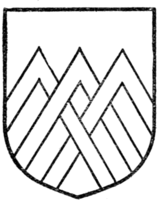THE SO-CALLED ORDINARIES
125
the angles and proportions of the pile are very much at the discretion of the artist, and governed by the charges which need to be introduced in the field of the escutcheon or upon the pile.
A single pile may issue from any point of the escutcheon except the base; the arms of Darbishire showing a pile issuing from the dexter chief point.
A single pile cannot issue in base if it be unaccompanied by other piles, as the field would then be blazoned per chevron.
Two piles issuing in chief will be found in the arms of Holles, Earl of Clare.
When three piles, instead of pointing directly at right angles to the line of the chief, all point to the same point, touching or nearly touching









